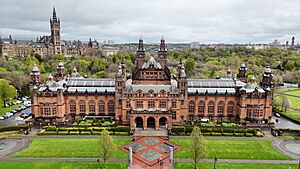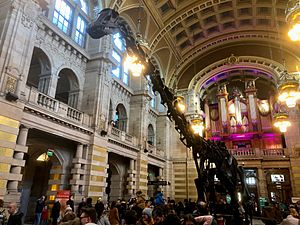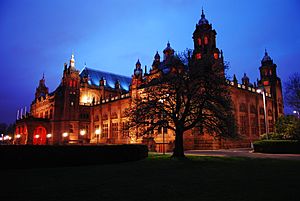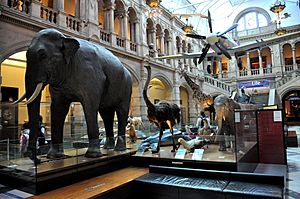Kelvingrove Art Gallery and Museum facts for kids
 |
|
| Established | 1901 |
|---|---|
| Location | Argyle Street, Glasgow G3 8AG, Scotland |
| Visitors | 1,283,882 (2023) |
The Kelvingrove Art Gallery and Museum is a super cool place in Glasgow, Scotland. It's a museum and an art gallery all in one! You can find it in Kelvingrove Park, right next to Argyle Street. It's one of Scotland's most popular places to visit, and guess what? It's free!
It opened way back in 1901. Inside, you'll discover amazing things like ancient Egyptian treasures, cool designs, old weapons and armor, and lots about Scottish history and Glasgow. It also has a huge art collection from all over the world – Scotland, Europe, Africa, Asia, and even Oceania.
Kelvingrove closed for three years for a big makeover and reopened in 2006. This huge project cost about £27 million! The museum's collections were then split into two main parts: "Life" and "Expression." The "Life" galleries show off natural history, human history, and ancient times. The "Expression" galleries are where you'll find all the beautiful art. There are 22 galleries in total, displaying over 8,000 objects! Some famous things you can see include Salvador Dali’s painting Christ of St John of the Cross, a huge Asian elephant named Sir Roger, the amazing Avant armour, and paintings by the Glasgow Boys and the Scottish Colourists.
Contents
How the Museum Started
The very first Kelvingrove Museum opened in 1870. It was called the City Industrial Museum and was Glasgow's first museum run by the city. It was located in Kelvingrove House, a large house built in 1783. This house used to be the home of a important city leader named Patrick Colquhoun.
Kelvingrove House stood where the skatepark in Kelvingrove Park is now. The museum's collection grew so much that a new part was added to the house between 1874 and 1876. The original Kelvingrove House was taken down in 1899, and the museum part was removed in 1911.
Building the Current Museum (1888–1901)

The money to build the current Kelvingrove museum partly came from a big event called the 1888 International Exhibition. This exhibition was held in Kelvingrove Park. The museum building was designed by two architects, Sir John W. Simpson and E.J. Milner Allen. It opened in 1901 as the Palace of Fine Arts for another big event, the Glasgow International Exhibition.
The building is made in a Spanish Baroque style. It uses red sandstone from Locharbriggs, which is a common building material in Glasgow. Many sculptors, like George Frampton and William Shirreffs, created beautiful stone carvings for the building.
The Grand Pipe Organ
The main feature in the Centre Hall is a huge pipe organ. It was built by a company called Lewis & Co. This organ was first made for the 1901 Glasgow International Exhibition. It was in the exhibition's concert hall, which could hold 3,000 people!
The Centre Hall of the new Art Gallery and Museum was always meant to host concerts. When the 1901 exhibition ended, a city leader suggested that Glasgow should buy the organ. He said that without it, "the art gallery would be a body without a soul." The money to buy and install the organ came from the extra funds left over from the exhibition. The organ was then placed in the Centre Hall.
The Back-to-Front Myth
There's a funny story in Glasgow that the museum was accidentally built facing the wrong way. The myth says the architect was so upset he jumped from one of the towers! But this isn't true. The main entrance was always planned to face into Kelvingrove Park.
Big Makeover (2003–2006)
Queen Elizabeth II officially reopened Kelvingrove on July 11, 2006. This was after it had been closed for three years for a huge makeover. The work cost about £35 million! A lot of the money came from the Heritage Lottery Fund and from people donating money.
The makeover added a new restaurant and a large basement area for more displays. This new space helped show off the 8,000 objects now on display. The museum also got a new layout to make it easier for visitors to find their way around. As part of the changes, a Spitfire airplane (serial LA198) was hung from the ceiling above the "Life" gallery. This Spitfire used to belong to the 602 (City of Glasgow) Squadron.
After its reopening, Kelvingrove became the most popular free museum in Scotland. In 2007, over 2.23 million people visited! This made it the most visited museum in the United Kingdom outside of London that year. From 2006 to 2009, the museum welcomed 5 million visitors.
Amazing Collections
The museum's collections mostly came from the first Kelvingrove Museum and the McLellan Galleries. It has one of the best collections of old weapons and armor in the world! It also has a huge collection of natural history items, like animals and plants.
The art collection is truly special. It includes many famous European artworks. You can see paintings by Old Masters like Rembrandt van Rijn. There are also works by French Impressionists such as Claude Monet, Pierre-Auguste Renoir, and Vincent van Gogh. You'll also find art from the Scottish Colourists and artists from the Glasgow School.
Famous Artworks
The museum is home to Christ of Saint John of the Cross by Salvador Dalí. The museum's curator bought the rights to this painting after meeting Dalí himself! For a while, from 1993 to 2006, the painting was moved to the St Mungo Museum of Religious Life and Art.
The museum also has a large collection of decorative arts. This was a gift from Anne Hull Grundy, who loved collecting art. It shows the history of European jewelry from the 1700s and 1800s.
Images for kids
-
Head and upper body of the goddess Sekhmet, Egypt, 18th dynasty, reign of Amenhotep III, 1390-1352 BCE
-
Portrait of the Art Dealer Alexander Reid by Vincent van Gogh, 1887
-
A Man in Armour by Rembrandt, 1655 (?)
-
Paul Gauguin, Østre Anlæg Park, Copenhagen, 1885
-
The Tuileries Gardens, Paris by Camille Pissarro, 1900
See also
 In Spanish: Museo Kelvingrove para niños
In Spanish: Museo Kelvingrove para niños















